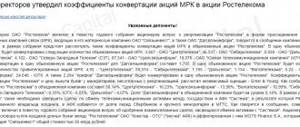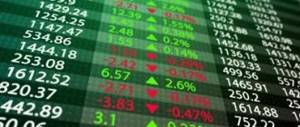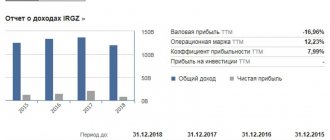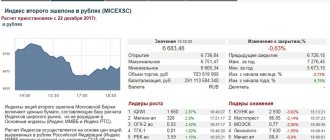Financial has implemented an extremely useful service for investors on its network resource. On the Finam website, the leaders in growth and decline in exchange trading are filtered and ranked according to various criteria. Thus, traders and investors can select suitable financial instruments for trading operations.
Study the biggest movers and shakers in the financial markets.
Stock quotes
Russian shares
- FINAM - selection by instruments
- BCS - leaders of growth and decline
- Smart-lab - by indicators
- Trading view - any charts
- Investing - top Moscow Exchange
- Moex - quote history
- RBC - by trading volume
Foreign shares
- Investing - USA realtime
- Trading view - with deep filters
- Finviz
- Finviz - market map (S&P500)
- Yahoo Finance - quote history
- Investfunds - NYSE, LSE, HKSE
- SPB Exchange - SPB realtime
Indexes
Financial markets from TradingView
Leaders of growth and decline
- BCS - blue chips
- FINAM - by sector
- Investfunds - entire Moscow Exchange
- Trading view - US leaders
- Investing - Russian shares
Buffett indicator
Buffett's indicator is also being questioned.
Warren Buffett suggests dividing the stock market capitalization by the country's GDP. It compares only 2 indicators.
According to theory, if the ratio of market capitalization to global GDP exceeds 137%, then the market is greatly overvalued. If the indicator is below this value, especially below 100%, then the market is undervalued. Now the figure has exceeded 200%.
Buffett indicator
| The market is overvalued | The market is undervalued | Current | |
| Indicator value (%) | Exceeds 137 | Below 100 | 200 |
Graph of weighted index of company market value and US GDP
The weighted index of the market value of all US companies has been exceeding the size of the GDP of the American economy for 8 years. This does not mean that collapse will inevitably await us around the first corner.
The Fed is inflating its balance sheet, keeping rates low.
Stock Screeners
Services that help you select stocks using various useful filters. Volume, percentage of price changes, graphic patterns, etc.
Russian market
- Tradingview - screener for Moscow Exchange shares
- Investing - stock filter, MOEX
US stock market
- Finviz - stock filter screener
- Hamaha - AMEX, NASDAQ, NYSE
- Barchart - a large number of filters
- Tradingview - NASDAQ, NYSE, OTC
- Yahoo Finance
- MarketWatch
- OTCMarkets
- Stock Watcher
- Wallmine
- Google Finance - screener from Google
- MorningStar
The Russian stock market is declining due to external negativity
MOSCOW, May 11 — PRIME. The Russian stock market is declining on Tuesday against a negative external background caused by rising inflation fears in the United States, as follows from trading data.
The ruble is growing against the dollar and the euro
The Moscow Exchange ruble index by 15.50 Moscow time falls by 1.69%, to 3632.39 points, the RTS index - by 1.78%, to 1542.79 points.
The dollar exchange rate in “tomorrow” calculations decreased by 18 kopecks, to 74.17 rubles, the euro rate increased by 4 kopecks, to 90.25 rubles.
July Brent crude futures fell 1.29% to $67.44 per barrel.
The main American indices generally fall in the range of 0.79-2.17%, the leading European indices - up to 2.65%.
MARKET UNDER PRESSURE
On Tuesday, Russian indices opened with a large downward gap, leveling the growth of several previous sessions due to an extremely negative external background, notes Dmitry Babin from BCS World of Investments.
According to him, Monday’s downward movement on world markets developed - the negative was the renewed growth in US government bond yields, which on Friday quickly recovered after the failure caused by the weak report on the American labor market.
Analysts named the reason for Russia's economic lag
“The acceleration of price growth puts pressure on quotes. Five-year inflation expectations in the United States have reached their highest level since 2006. The rise in prices for commodity assets occurs against the backdrop of the recovery of the global economy and the soft policies of leading Freedom Finance.”
An additional factor spurring the rise in prices of commodity assets is the weakening of the American currency, adds Pigarev.
The Russian stock market is experiencing negative pressure from a significant decline in world indices. A mitigating circumstance is that the technology sector, which is at the epicenter of a correction in international markets, is poorly represented in the Russian Federation, explains Sergei Kaufman from Finam Group of Companies.
Falling oil prices and the dividend gap in Sberbank shares do not allow us to fully take advantage of this advantage, he concludes.
The negative dynamics are due to both increased inflation fears and weak labor market statistics in the US for April, says Alexander Osin from Freedom Finance.
LEADERS OF FALL AND GROWTH
Sberbank shares at the beginning of trading on Tuesday fell significantly in price after the dividend cutoff - since May 11 they have been trading without dividends. The maximum drop in ordinary shares on Tuesday was 6%, to 301 rubles, and preferred shares - 6.3%, to 280.24 rubles.
Securities of Russian companies fall in price at auction in London
On Tuesday, Sberbank presented its RBSU reports, which were unable to fully compensate for the dividend gap. The credit institution's net profit for January-April of this year increased 1.7 times - to 386.1 billion rubles, while in April it earned a record 103.6 billion rubles.
Sberbank shares remain the leaders of the fall, having won it back a little: ordinary shares are down by 3.76%, preferred shares are down by 3.87%.
Tinkoff Group (TCS Group) presented its IFRS financial statements for the first quarter of 2021.
The group's net profit grew by 57% year on year and amounted to 14.2 billion rubles. Its assets since the end of 2021 increased by 1.7%, to 873.5 billion rubles. In addition, the group maintained its expectations for net profit under IFRS for the current year in the amount of at least 55 billion rubles and confirmed plans to resume paying dividends in 2022.
By mid-trading, the bank's shares were down 1% after yesterday's rally, notes Sergei Kaufman from Finam Group of Companies.
Shares of TGK-2 (-3.51%), Detsky Mir (-3.05%), RBC (-2.51%), Lukoil (-2.03%), Petropavlovsk ( -1.96%), Rosseti (-1.69%), VTB (-1.54%), Aeroflot (-1.41%), Alrosa (-1.35%), MKB (-1.31%), as well as receipts of Mail.ru Group (-2.36%) and OZON (-1.78%).
The shares of the Moscow Exchange (+1.41%) are acting as a protective asset today, points out Alexander Osin from Freedom Finance. The reason for their purchase is optimistic expectations regarding the company's income in the face of increasing volatility, as well as corporate news, the analyst specifies.
The Moscow Exchange acquired 70% in the electronic platform for the selection of insurance and banking products INGURU. Within five years, this share can be increased to 100%.
The growth leaders were shares of Raspadskaya (+2.65%), RusHydro (+1.5%), Rosinter (+1.45%), Surgutneftegaz (+1.37%) and M.Video (+1.24%), as well as HeadHunter receipts (+1.17%).
FORECASTS
The immediate support for the Moscow Exchange index is at 3,600 points, for the RTS index at 1,524 points, estimates Dmitry Babin from BCS World of Investments. “If the downward dynamics of global markets accelerates, we can test the strength of these technical obstacles today,” the expert believes.
Moscow Exchange bought 70% of the platform for selecting insurance and banking services
If the correction continues, the Moscow Exchange index may be supported by the lower limit at 3570 points, believes Sergei Kaufman from Finam Group of Companies.
In the second half of the current session, a technical recovery of the market is possible, predicts Alexander Osin from Freedom Finance. The analyst calls the closing target for the Moscow Exchange index a range of 3625-3730 points.
The Russian stock market will show weak dynamics amid increasing sales in world markets, expects John Walsh from Alfa Bank. In his opinion, sales of shares in the technology sector on global markets could trigger a decline in the market as a whole.
Demand for gold and metals producers will continue on Tuesday, Walsh continues. Gold prices are rising, while the dollar remains weak, he notes. At the same time, strong oil prices will support shares in the oil and gas sector, the analyst believes.
Growth stocks - outperforming stock market averages
Companies that can grow faster than the industry average over a long period of time tend to be rewarded by the market while providing significant returns to investors. And the faster they grow, the higher the return in the form of rising quotes.
Here are 10 securities that are examples of growth stocks available in the stock market:
| No. | COMPANY | 3-year CAGR (compound annual growth rate) | MARKET SECTOR |
| 1. | Shopify (NYSE:SHOP) | 46 % | E-commerce |
| 2. | Alibaba (NYSE:BABA) | 35 % | E-commerce and cloud computing |
| 3. | Square (NYSE:SQ) | 43% | Digital payments |
| 4. | MercadoLibre (NASDAQ:MELI) | 55 % | E-commerce |
| 5. | Facebook (NASDAQ:FB) | 24 % | Digital advertising |
| 6. | JD.com (NASDAQ:JD) | 25 % | E-commerce |
| 7. | Netflix (NASDAQ:NFLX) | 29 % | Streaming services |
| 8. | Amazon (NASDAQ:AMZN) | 23 % | E-commerce and cloud computing |
| 9. | Salesforce.com (NYSE:CRM) | 30 % | Cloud software |
| 10. | Alphabet (NASDAQ:GOOG), (NASDAQ:GOOGL) | 17 % | Digital advertising |
While all of the stocks on this list are large-cap stocks, stocks from smaller companies can also offer huge growth potential.
As this list shows, companies with assets classified as growth stocks can operate in a variety of industries, both within the United States and in international markets.
Assessing the company's potential for growth
There is no absolute formula for assessing the growth potential of asset prices. Indicators are used based on individual interpretation of factors based on objective and subjective factors. In some cases, the investor's personal conviction and even rumors.
Growth investors may use certain methods or criteria as the basis for their analysis, but these methods must be applied taking into account the specific situation of the company. That is, after analyzing its current position, in comparison with previously achieved production and financial indicators.
Overall, a growth investing strategy looks at five key factors to select companies that can provide capital growth. These include:
- Strong historical growth of the company's profit, at least over the last 5 years. The minimum earnings per share ( EPS ) growth depends on the size of the company. For example, for an organization with a capitalization of $4 billion , growth should be at least 5% . For smaller capitalization companies ( $400 million to $4 billion ), annual earnings growth should be within 7% . If a company, even with a small capitalization, demonstrates business expansion, it will develop successfully in the foreseeable future.
- Strong forward earnings growth. An earnings announcement is the official publication of earnings. Usually quarterly or annual. This information is published on specific dates, but they are preceded by profitability forecasts issued by financial analysts. It is the forecast and real indicators that investors evaluate when choosing stocks whose growth rates will be higher than the industry average.
- A company's high pre-tax profit margin is calculated by deducting all expenses from sales ( excluding taxes ) and dividing them by sales volume. This is an important metric to consider because a company can have fantastic sales growth but poor earnings growth. This may indicate that management is not controlling expenses and revenues.
- High return on equity ( ROE ), which demonstrates the amount of profit generated from the money received from investors. This ratio is calculated by dividing net income by shareholders' equity. A comparison is made of the company's current ROE with the average ROE of the enterprise and industry over the past five years. A stable, or better yet, growing ROE indicates that management is successfully generating profits from shareholder investments and effectively managing the business.
So unless assets have actually doubled in the last 5 years, it's unlikely to be a growth stock. Statistics confirm that with an annual of 10% , the company's share price doubles in 7 years.
For capitalization to double, the share price must grow by 15% . We can say that these indicators allow us to call the assets of even a young company growth shares.
Investing in growth stocks
Investing in growth stocks can be seen as a great way to quickly build wealth in the stock market. The key is to know which growth stocks to buy. And when should I do it?
Using a similar strategy, also called “ capital growth ” or “ capital appreciation ,” means investing in young or small companies whose earnings are growing at a rate that exceeds the level of the industrial sector or the entire market.
Growth investing looks attractive to many investors because buying shares of growth companies can provide impressive returns if the issuer is successful. However, investing in many of these fast-growing companies often comes with high risk.
Growth investors typically look for investments in companies operating in high-growth industries. Where innovative technologies are rapidly being introduced, new services are offered. In this case, income is generated by increasing the value of assets, which investors receive during the sale of these securities.
These are, as a rule, small and young companies or firms that have only recently held an IPO , becoming public. Growth investors base their calculations on the assumption that the company will prosper and expand. Expansion of a young and promising business will ultimately lead to higher share prices in the future.
Thus, growth stocks can trade at high price-to-earnings ( P/E ) ratios. Very often, calculations are based on certain prospects that make them industry leaders, namely:
- ownership of certain patents;
- access to revolutionary technologies that can radically improve production processes.
To stay ahead of the competition, such companies often reinvest profits into developing even newer technologies and patents to ensure long-term growth. That's why they don't pay dividends.









